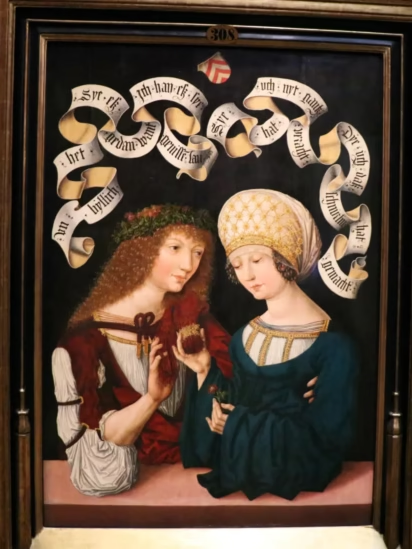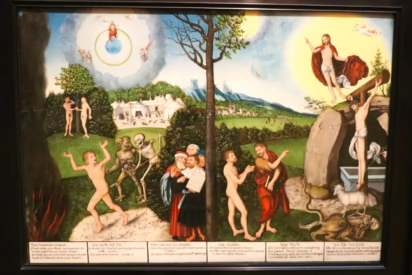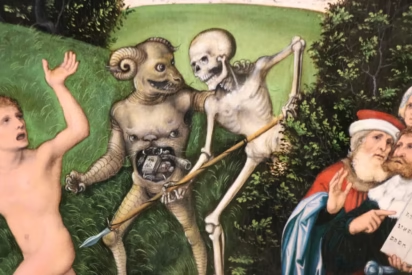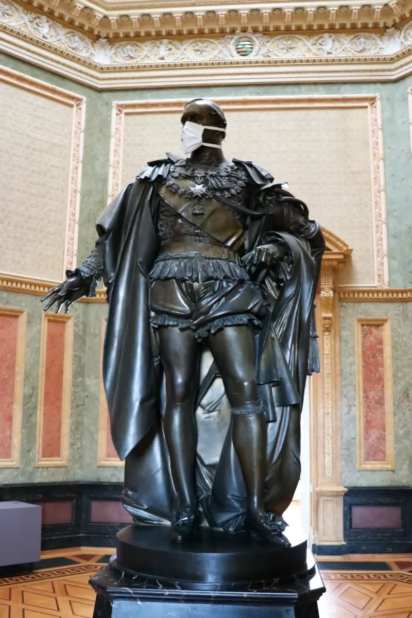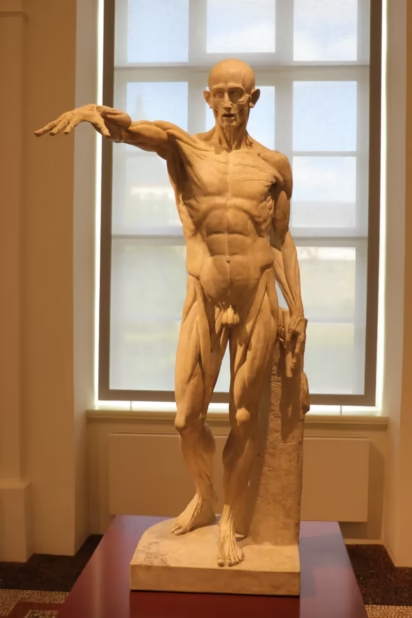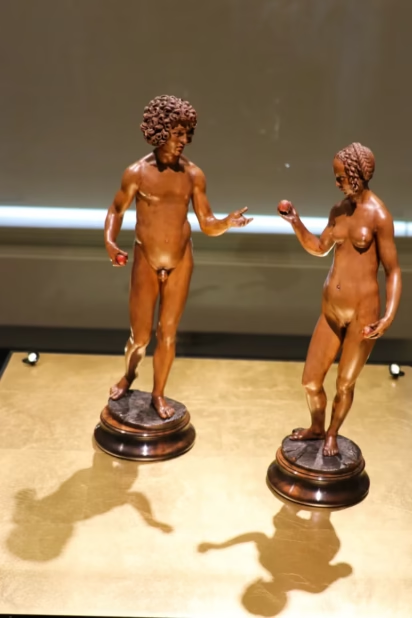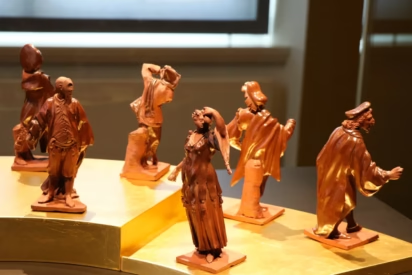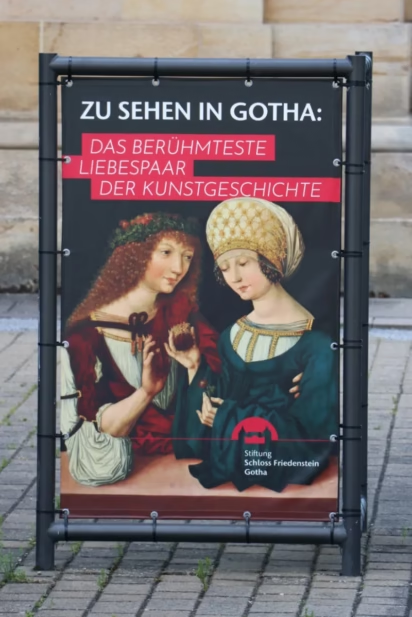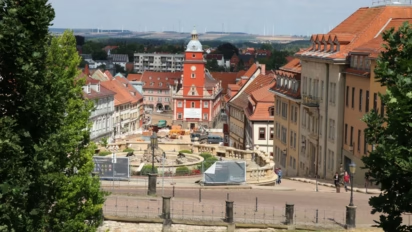The Herzogliches Museum (Ducal Museum) is a large art collection including the Gotha Lovers (Gothaer Liebespaar), Asian art, antiquities from Egypt in the park of Schloss Friedenstein.

The Herzogliches Museum (Ducal Museum) is in a large late-19th-century historicist building in the landscape park of Schloss Friedenstein in Gotha in Thuringia in central Germany. The core of this impressive exhibition is still the art collection of the former dukes of Saxe-Gotha. The best-known work here is the Gotha Lovers (Gothaer Liebespaar) but the museum has a fine collection of old German and Dutch masters, sculptures, porcelain, graphic art, Japanese lacquerware, chinoiserie, and one of the oldest Egyptian collections in Europe.
Gotha Lovers Painting
The Gotha Lovers (Gothaer Liebespaar) from around 1480 is the most important painting in the Herzogliches Museum. The museum describes this work as the Mona Lisa of Thuringia and as important a landmark in German medieval art as the Bamberger Reiter and Uta von Naumburg.
This 118 x 80 cm painting shows a man and a woman together in a single frame and is considered the first large portrayal of a non-liturgical couple in German art. The roses and words indicate love and fidelity. The Gotha Lovers is currently usually attributed to the Master of the Amsterdam Cabinet (Hausbuchmeister) — previously also to Hans Holbein, Matthias Grünewald, and even Albrecht Dürer.
The painting is often described as an idealistic portrayal in the spirit of courtly love of the middle ages rather than a portrait of specific individuals. However, some considered them to be Duke Philip of Hanau-Münzenberg and his lover Margarete Weißkirchner. They lived fairly openly together following the death of his first wife but could not marry as she was not from the nobility.
Paintings in the Ducal Museum in Gotha

The Liebespaar share the hall with several further early German masters from the 15th and 16th centuries. Lucas Cranach the Older is well represented with further works from his workshop and son. Cranach was as comfortable at painting biblical as mythological scenes, his ruler (Elector of Saxony), Martin Luther, and other prominent figures from the age. (His workshop was skilled at copying these portraits — any decent art museum in Germany has a few.)
Probably the most interesting Cranach on display is “Damnation and Salvation” — it shows Luther’s teaching of every individual having to justify his actions before God. The tree of life divides the painting and action into two: left the sinful being driven to hell by the devils and to the right the repenting sinner finding eternal life through the grace of God. Hieronymus Bosch would have approved of one devil’s stomachs.
The huge Gothaer Tafelaltar is by Heinrich Füllmauer (around 1538). This large altar with 162 scenes one of the largest works of old German art — parts of the altar, including the family tree of Christ failed to return from Moscow after the Second World War. This post-Reformation monumental illustration of the Bible uses many passages from the Martin Luther translation of 1522 to explain Biblical events and parables.
The collection also has many works of Flemish and Dutch origin from the 17th and 18th centuries including one by Peter Paul Rubens. Further German masters include “Cross in the Mountains” (1820/21) by romantic painter Casper David Friedrich, and several historical scenes painted by Tischbein.
Sculptures in the Herzogliches Museum Gotha
Sculptures are scattered throughout the building and also outside but a dedicated sculpture collection is on display on the ground floor. Highlights include 22 sculptures by French classical sculptor Jean-Antoine Houdon — the largest collection of his works outside France.
Also, note the small Adam and Eve carved from boxwood around 1515 by Conrat Meit. Adam and Eve gave medieval artists a rare legitimate opportunity to produce a human nude. The bodies are smooth but both have elaborately carved hairstyles. (In the Kunstkammer in the palace is another carved Adam and Eve from the same period.)
Further statues decorate the monumental staircase with a large bronze of Duke Ernst II of Saxe-Coburg and Gotha clearly showing off his membership of the British Order of the Garter. (German nobles mostly lost their extensive British titles and orders at the end of the First World War. See Visit Schloss Friedenstein Castle and the Baroque Universe of Gotha for more on the strong links between the House of Saxe-Coburg and Gotha and the British royal family.)
Ceramics and Asian Art
In addition to the paintings galleries, the top floor of the museum has several small exhibitions. Only top works are on display. The actual collections are far bigger — the curators may select for example from around a thousand fans and over 35,000 drawings for the frequently rotating displays.
Fans were a popular fashion accessory at court and some where of high artistic value or with exquisite details. By the early 19th century, Duke August had a collection of over 400 fans. Only a small selection is displayed and for conservation reasons changed frequently.
The ceramic collection range from prehistory to the present. The Meissen porcelain, Italian Renaissance majolica, and Delftware are particularly noteworthy. The collection of reddish stoneware, produced by Johann Friedrich Böttger while trying to find the mystery of Chinese white porcelain, includes many unique works and is the largest in the world after the Zwinger in Dresden.
The Asian rooms have mostly 19th-century lacquerware from Japan and chinoiserie on display. Around 1800, the East Asian collection of 2,232 cataloged items was one of the largest in Europe and filled the six rooms of the China Cabinet inside the castle. The collection has since shrunk to around 600 items of which only a small number are on exhibited.
Antiquities in Gotha
The antiquities display in the basement of the museum is fairly small but absolutely worth a quick visit as many of the works are of very high artistic quality.
The museum has one of the oldest Egyptian collections in Europe including a few mummies and burial artifacts. (The finest early Egyptian collection in Germany is somewhat surprisingly not in a major city but in the Roemer-Pelizaeus Museum in the relatively small town Hildesheim near Hannover.)
Other antiquities are from Greece and Rome with the collection of vases especially praised. The display is enhanced with late-18th-century cork models of several Roman monuments — Goethe studied these in preparation for his well-documented travels to Italy.
Visitor Information for the Baroque Universe of Gotha

The Ducal Museum may be seen separately from the castle and other sights in Schloss Friedenstein in the Baroque Universe of Gotha.
Opening Hours of Schloss Friedenstein
The Ducal Museum (Herzogliches Museum) and the museums in Friedenstein Castle are open Tuesday to Saturday from 10:00 to 16:00, closing at 17:00 from April to October.
The museums are closed on Monday but usually open if a holiday.
The Schloss Park is unfenced and thus always freely accessible.
Admission Tickets to Friedenstein in Gotha
Admission tickets are available at the Ducal Museum or from the main ticket office in the passage in the north wing of the castle.
The Friedenstein-Karte is €10 and includes all sights on the same day. It is also possible to buy individual tickets for €5 for the Ducal Museum, or the Nature Museum and Ekhof Theater.
Admission is free for children under 17.
Photo permission is €5 for the day.
Audio guides are available but almost all descriptions inside the museums are in both German and English.
Restaurant Pagenhaus in the northwestern corner of the palace (nearest to the town center) offers both good local cuisine meals or simpler coffee and cake — usually open from noon. Otherwise, it is a short downhill walk to many further options in the town center. There is also a basic cafe in the basement of the Ducal Museum building.
Transportation to Gotha
Gotha in Thüringen is easily reached on public transportation or by car. The castle is on a hill inside the large park, which is in-between the old town center and the modern train station.
The parking lot at the south side of the palace — P20 Südrampe Schloss — charges but is on the same level as the palace. Parking at the Ducal Museum and on the edge of the park is mostly free but note any time restrictions.
Gotha train station is on the south side of the modern town away from the historic center. It is a pleasant ten-minute walk to the castle. From the station, follow Kunstmühlenweg one block north and then walk through the park from Parkstraße — across from the Netto supermarket. The Länder-Tickets (state tickets) are great value when traveling only on local trains and buses in Thuringia, Saxony, and Saxony-Anhalt — the same price; all cover travel in all three states. See trains to Gotha for timetables.
Gotha has only a limited number of hotels — see Tripadvisor — but Thuringia is fairly small with good transportation making it of little importance in which city visitors sleep while sightseeing. Eisenach, Erfurt, and Weimar are nearby, as are many other pleasant smaller towns with rich cultural heritage.
See also:
- Visit Schloss Friedenstein Palace and the Baroque Universe of Gotha.
- More photos on Flickr of Schloss Friedenstein and the museums.
